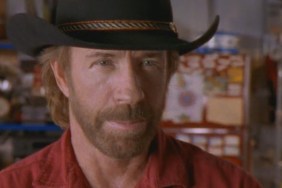We all know the Lone Ranger. The white hat. The mask. Tonto, his trusty sidekick, and Silver, his noble steed. We know that he’s a symbol of nobility and of justice and that he’s going to do everything it takes to fight for what’s right in the American West.
Why do we know that? To the best of my knowledge, I’ve never sat through more than maybe a clip of the classic television series and I’ve never listened to the radio show. I’ve never seen another Lone Ranger film or followed his adventures in a comic book, but the character himself has reached a level of pop culture familiarity and is now embraced as an American icon to the degree that the character lives independently of any specific story.
The first time I became truly interested in Gore Verbinksi’s take on the project was three years ago when I interviewed him about his last team-up with Depp, the surreal animated western Rango.
“It’s sort of ‘Don Quixote,'” he told me, “told from Sancho Panza’s point of view.”
At the time, I imagined that Verbinski’s vision for the film was going to be something a lot more literal and that maybe we’d see an older, senile John Reid in the final days of the American west, fighting for the same impossible dream and kept in check by a more able-bodied Tonto, inspired by the Ranger’s inextinguishable altruism. I like the idea of that a lot and, honestly, after watching the final film, it’s still pretty close to what I see.
We’re having a weird summer for American icons. Our movies are surrounded by the reminder that America is not a friendly or necessarily safe place and we’re turning to our highly virtuous heroes to see how they deal with the unrelenting cynicism of reality. The crew of the Enterprise is discovering that Starfleet is corrupt and Superman is learning that its sometimes necessary to kill. On the whole, I don’t have a problem with any of that, because I believe that the very best stories that can be told are the ones that remind us to be noble and good in the face of absolute disenchantment.
As far as sources of disenchantment go, America’s own history serves as depressingly fertile ground and I can’t help but think that there’s genuinely something ballsy about a big-budget studio film timed for an Independence Day release that depicts the American west as a dirty, violent place while simultaneously suggesting that our march of progress to escape those days was often built on treachery, deceit and death. The bad guys are the men who built the railroads and being asked to remember the historical fact that progress is not always achieved through pleasant means serves as an absolute counterpoint to the Lone Rangers role as an American paragon.
Quite a few of the films detractors have criticized Depp playing Tonto as a sort of Hollywood whitewashing and while I certainly sympathize with the idea of giving a Native American actor a major summer blockbuster role, the fact of the matter is that this is a film that barely happened with Depps name attached and, more importantly, happened because its a story that Depp had particular interest in bringing to the screen. Im not quite certain when the what have you done for me lately? tide turned against the man, but if playing Tonto is something that Depp is passionate about, the idea of telling him that he cant because hes not Native American is as terrible as the reverse.
But theres a deeper level to Depps involvement that really fascinates me and thats because the entirety of the film can be seen as a self-referential investigation into revitalizing an American icon in the first place. The crow that sits atop of Tontos head is the Lone Ranger. For all intents and purposes, its just a big dead symbol (and, depending on who you ask, should stay dead) but the notion of, against all sanity, feeding it and imbuing it with a kind of spirit is its own microcosm of the impossible dream that saturates the entire film. After all, it is literally Depp who has brought the Ranger back from the dead and aides him as he walks through both reality and fiction, accompanied by the big grinning Disney horse (and I genuinely miss movies with big grinning horses).
The environment of The Lone Ranger is very much the same territory Depp and Verbinski explored in Rango. Theres a sense of existential soul-searching and an overarching look at the balance between truth and reality. In the junket interviews (watch them here and here), I brought up John Fords The Man who Shot Liberty Valance and was delighted when Verbinski confirmed that it was a direct influence. One of the very best westerns of all time, the 1962 film ultimately argues that right fiction has a greater truth to it.
This is the West, sir, a reporter tells Jimmy Stewart at the end of that film. When the legend becomes fact, print the legend.
Thats the central theme of The Lone Ranger, too. What is the legend of the American West? Its a question asked by both the filmmakers and the characters alike in that Tontos interpretation of the narrative blends in supernatural elements that other characters actively discredit. What then, ultimately, is the self-contained reality of the film? Thanks to a delightfully bizarre framing device, its sort of a fiction delivered decades later by a senile mannequin come to life in the mind of a little boy. The fact that everyone is so quick to write off the bookend’s surreal charm is the reason we can’t have weird things.
“I wish such fault-finders were more lenient and less exacting,” Sampson Carrasco tells Don Quixote in the original text, “and did not pay so much attention to the spots on the bright sun of the work they grumble at; for if aliquando bonus dormitat Homerus, they should remember how long he remained awake to shed the light of his work with as little shade as possible; and perhaps it may be that what they find fault with may be moles, that sometimes heighten the beauty of the face that bears them; and so I say very great is the risk to which he who prints a book exposes himself, for of all impossibilities the greatest is to write one that will satisfy and please all readers.”
What I take away from The Lone Ranger is the message that our heroes are genuinely real so long as they inspire us. Regardless of whether or not the film is wholly successful in delivering that message is certainly up for debate, but it does offer a landscape painted with Verbinksi’s auteur brushstrokes. It’s a strange dream, to be sure, but I suspect that it’s one that will be dreamed for a very, very long time to come.










